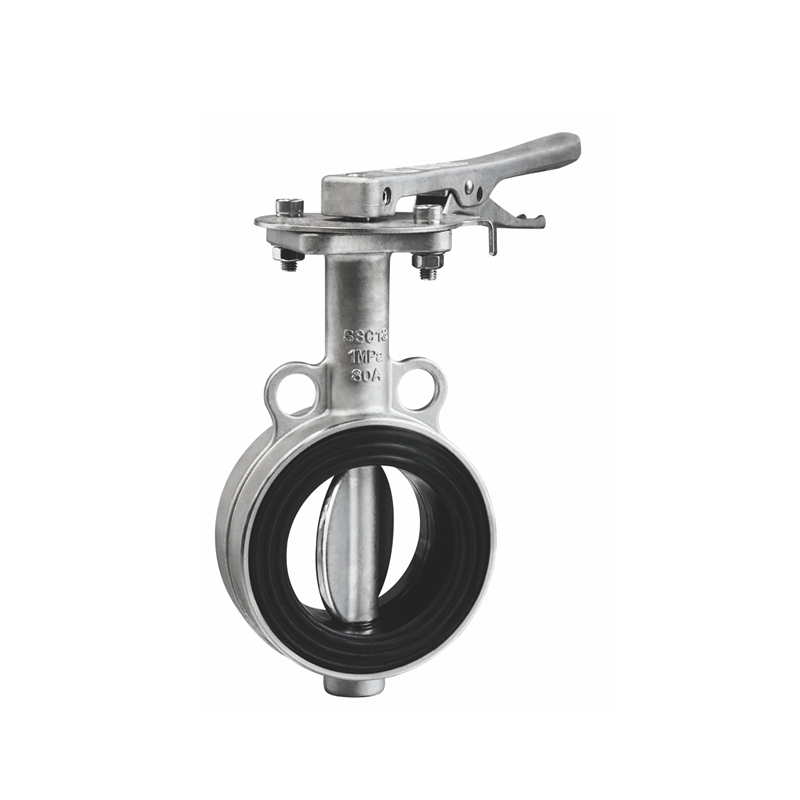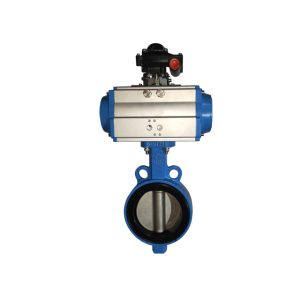Table of Contents
ToggleButterfly valves are a type of valve designed to control flow in various fluid services.
First developed during the 1930s, these devices have become ubiquitous across a variety of industries today.
When selecting a butterfly valve, there are two primary types: lug and wafer.
Both work in a similar fashion; however, the choice between them depends on your application.
Selecting the ideal butterfly valve depends on your project requirements.
Lug-style butterfly valves are usually made of metals, while wafer-style butterfly valves are composed of plastics and can be operated pneumatically or electrically.
What is a lugged butterfly valve?
A lugged butterfly valve is a type of butterfly valve that has lugs or tabs on the valve body.
These lugs allow the valve to be bolted directly to a flange connection without the need for additional hardware, making installation and maintenance easier.
What is a wafer butterfly valve?
A wafer butterfly valve is another type of butterfly valve that is designed to fit between two flanges using bolts or studs.
Unlike a lugged butterfly valve, a wafer butterfly valve does not have lugs or tabs on the valve body. Instead, it relies on the pressure of the fluid to hold it in place between the flanges.
Quick Summary of Key Differences Between Lugged and Wafer Butterfly Valve
Butterfly valves are widely used in various industries for regulating or isolating fluid flow. They feature a simple design with a disc that rotates on a central axis to either allow or block flow.
Among the types of butterfly valves, lugged and wafer designs are the most common.
Understanding their differences is essential for choosing the right valve for your specific application.
| Aspect | Lugged Butterfly Valve | Wafer Butterfly Valve |
| Design and Construction | Features threaded inserts (lugs) on the valve body, allowing it to be bolted between flanges. | Lacks threaded inserts and is sandwiched between flanges using long bolts. |
| Installation Methods | Can be installed in end-of-line service or between flanges for full flow control. | Installed between flanges with bolts passing through both the valve and flanges. Not suited for end-of-line service. |
| Cost Comparison | Generally more expensive due to its robust design and versatility. | More cost-effective, offering a lighter and simpler construction. |
| Pressure Ratings and Performance | Suitable for higher pressure applications; offers better sealing and isolation. | Handles lower to moderate pressures effectively, but may not offer as strong a seal as the lugged design. |
| Maintenance Requirements | Easy to maintain; the valve can be removed without disturbing the piping system. | Requires removing the entire valve during maintenance, which can disrupt the system. |
Advantages of Lugged Butterfly Valves
Lugged butterfly valves are designed with threaded lugs along the outer edges of the valve body.
These allow the valve to be bolted between flanges, making it possible to isolate sections of the piping system if needed.
This design makes lugged valves a popular choice for industrial applications.
| Advantage | Explanation |
| Durability and Strength | Lugged valves are known for their robust construction, making them ideal for demanding environments. |
| Ease of Maintenance | These valves can be removed for maintenance without affecting the rest of the piping system. |
| Versatility in Applications | They are versatile and can be used in dead-end service as well as for full flow control. |
Advantages of Wafer Butterfly Valves
Wafer butterfly valves are simpler in design compared to their lugged counterparts.
They do not feature threaded lugs for bolting but are instead sandwiched between two pipe flanges — relying on the bolts to hold the valve in place.
This design makes wafer butterfly valves lighter and more cost-effective, which makes them ideal for budget-conscious projects.
| Advantage | Explanation |
| Cost-Effectiveness | Wafer valves are generally more affordable than lugged valves, making them a good choice for cost-sensitive applications. |
| Compact Design | The wafer design is more compact, which saves space in systems where valve size matters. |
| Simplicity in Installation | Installation is quicker and easier as there are fewer components to align and secure. |
Choosing the Right Valve for Your Application
Selecting between lugged and wafer butterfly valves depends on various factors like pressure, flow rate, and space.
Additionally, typical use cases should be considered when making a decision.
Here’s a quick guide to help you make the right choice:
| Factor | Lugged Butterfly Valve | Wafer Butterfly Valve |
| Pressure | Suitable for high-pressure applications. | Best for low to moderate-pressure systems. |
| Flow Rate | Ideal for precise flow control in complex systems. | Suitable for basic flow control in less critical systems. |
| Space | Requires slightly more space due to its design. | Compact and space-saving, ideal for tight installations. |
| Typical Use Cases | Industrial applications such as oil, gas, and water treatment where strength and isolation are critical. | Used in water distribution and HVAC systems where simplicity and cost are priorities. |
In-depth Understanding the Difference Between a Lugged Butterfly Valve and a Wafer Butterfly Valve
Cost
Lugged butterfly valves are more expensive than wafer ones, but they offer a stronger connection. Unfortunately, they can be more challenging to install and maintain.
Lug butterfly valves are constructed from metals such as ductile iron or steel and feature threaded lugs on their flanges for bolt connections.
Wafer-style butterfly valves lack lugs and instead feature four holes that align with pipe flanges. Two piping flanges can be inserted through the butterfly valve’s centering holes, then tightened using two flange bolts – clamping the valve securely between both piping flanges.
Installation
Lugged butterfly valves are usually constructed from ductile iron or steel and feature threaded lugs on their flanges for bolt connections. This design makes them perfect for end-of-line service applications.
Conversely, wafer butterfly valves are lighter and less costly than their lug counterparts. Placed between pipe flanges, these valves utilize either a rubber or EPDM seat to form an incredibly strong seal.
Operation
Lugged butterfly valves feature threaded inserts (lugs) outside the valve that attach to piping flanges using bolted connections. This design allows one side of the piping system to be disconnected without interfering with another.
Wafer butterfly valves do not feature attachment lugs. Instead, they must be clamped between two piping flanges with either rubber or EPDM valve seats and can be fitted to most flange standards for use in various applications. They can be operated pneumatically or electrically for added convenience and dependability.
Maintenance
Butterfly valves are quarter-turn valves that restrict material flow in solid, liquid, or gaseous forms. They’re used in a range of applications like food processing, pharmaceuticals, and chemical and petroleum handling.
Lugged butterfly valves are composed of metal such as ductile iron or steel and feature threaded tapped lugs located on their flanges for bolt connections.
Lugged butterfly valves are widely used in high-pressure applications and can be operated using either electric or pneumatic actuation.
Wafer butterfly valves feature four holes that align with the pipeline being connected. They clamp between two flanges within the pipework, with either a rubber or EPDM valve seat providing an effective seal between them and their connection.
Valves are essential devices that open and close a fluid flow path. They play an essential role in any industrial process.
Wafer and Lugged Butterfly Valve FAQs
What is a wafer butterfly valve used for?
Wafer butterfly valves are commonly used in applications where space is limited or where a lightweight and compact valve is required.
They are often used in HVAC systems, water treatment plants, and industrial processes where quick and efficient flow control is needed.
What is a fully lugged butterfly valve?
A fully lugged butterfly valve is a type of butterfly valve that has lugs or tabs on both sides of the valve body.
This allows the valve to be bolted directly to flanges on both ends, providing a secure connection and preventing movement or vibration during operation.
What are the advantages of a lug butterfly valve?
Some advantages of lug butterfly valves include easy installation and removal, versatility in piping systems, and the ability to withstand high pressures and temperatures.
They are also cost-effective and require minimal maintenance.
What are the three types of butterfly valves?
The three main types of butterfly valves are concentric, double offset, and triple offset.
Concentric butterfly valves have a simple design with a stem in the center of the disc.
Double-offset butterfly valves have the stem offset from the center, while triple-offset butterfly valves have both the stem and the disc offset from the center.
How do I choose a butterfly valve?
When choosing a butterfly valve, consider factors such as the type of fluid being handled, the pressure and temperature requirements, the size of the valve, and the compatibility with the piping system.
It’s also important to consider the valve’s materials of construction and any industry standards or regulations that may apply.
What is the most common use of butterfly valves?
Butterfly valves are commonly used for flow control and isolation in a wide range of industries, including oil and gas, water treatment, chemical processing, HVAC, and power generation.
They are especially popular in applications where space, weight, and cost are important factors.
What is the difference between a lug and a wafer connection?
The main difference between a lug and a wafer connection is how the valve is attached to the piping system.
A lug connection uses lugs or tabs on the valve body to bolt the valve directly to flanges on the pipe.
A wafer connection, on the other hand, relies on the pressure of the fluid to hold the valve in place between two flanges.
What is semi lugged butterfly valve?
A semi-lugged butterfly valve is a variation of the lugged butterfly valve that has lugs or tabs on only one side of the valve body.
This allows the valve to be bolted directly to one flange, while the other end of the valve is held in place by the pressure of the fluid.
Exploring Reliable Lugged and Wafer Butterfly Valve Manufacturers
At Xintai Valve, we offer an extensive selection of high-quality industry valves, such as gate valves, globe valves, ball valves, check valves, and butterfly valves, to suit your needs.
Xintai Valve is one of the world’s leading producers of industrial valve products, boasting six ranges and thousands of varieties.
We have earned their customers’ trust by producing superior casting balls, gate, globe, check, and wedge valves for various applications.










